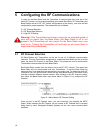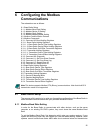
5 Configuring the RF Communications
In order for the Base Radio and the Transmitter to communicate they must be on the
same RF Channel, and must be transmitting at the same Baud Rate. All Transmitters and
Base Radios are set to RF OFF default configurations at the factory, and must be field
configured for proper operation. The subsections are as follows:
5.1: RF Channel Selection
5.2: RF Baud Rate Selection
5.3: High RF ID Setting
Warning! If the Transmitters have been running for an extended period of
time with no signal from the Base Radio (the Base Radio is off or not
present), the Transmitters will only search for the Base Radio every one
hour or so. Turning the Transmitters off and back on will cause them to
begin searching immediately.
5.1 RF Channel Selection
All Base Radios and Transmitters can be set to one of 16 different communication
channels. The only Transmitters recognized by a particular Base Radio are the units that
share the same RF Channel as that Base Radio. This allows the user to decide which
Transmitters communicate with each Base Radio.
Each Base Radio comes from the factory set to the RF OFF channel. This means the
Base Radio will not communicate with any Transmitters. To set the Base Radio for
communication, first determine the channel that you wish to use. To determine which RF
Channel to use, you should know if there are any other Base Radios in the same vicinity
and then choose a different channel number. After deciding on the RF channel number,
then follow the Base Radio menu map shown below in Figure 5-1 to configure the RF
Channel.
Figure 5-1 Menu Map to RF Channel Setting
Once you are in the RF Channel menu, you can increment it by pressing the NEXT
button. When selecting the RF Channel, do not choose an RF Channel that is currently
being used by other Honeywell Wireless Systems as this can cause communication
problems.
19


















